Tiny Space, Big Style: Living & Kitchen Combo Done Right
Tiny Space, Big Style: Living & Kitchen Combo Done Right
In a world obsessed with open-plan living, the living room kitchen combo has become a popular choice for maximizing space in smaller homes. But merging these two essential areas can be a daunting task. Achieving a seamless flow and maintaining distinct personalities for both spaces requires careful planning and execution.
This comprehensive guide dives deep into the nuances of creating a functional and stylish living-kitchen combo, tackling everything from layout and design principles to furniture selection, storage solutions, and essential decor tips.
The Allure of the Combo
The living room kitchen combo offers a unique blend of benefits:
- Enhanced Functionality: It creates a central hub for daily living, ideal for both entertaining and family gatherings. You can cook while chatting with guests or supervise children while preparing meals.
- Increased Space: By eliminating walls, the combo opens up the entire area, making it feel larger and more airy.
- Cost-Effectiveness: This setup often involves fewer walls to demolish and fewer finishes to purchase, saving on construction costs.
Layout Strategies: Maximizing Flow & Functionality
The success of your living room kitchen combo hinges on a well-planned layout. Here's how to create a functional and aesthetically pleasing space:
1. Define Clear Zones:
- Kitchen Zone: This area should be dedicated to cooking and food preparation. It includes the stovetop, oven, sink, dishwasher, and countertop space.
- Dining Zone: If your space allows, include a dedicated dining area with a table and chairs. This can be a separate corner or a bar counter integrated with the kitchen cabinetry.
- Living Zone: The living zone is where you relax, entertain, and unwind. It should include comfortable seating, a coffee table, and perhaps an entertainment center.
2. Consider the Flow:
- Traffic Patterns: Ensure easy movement between the kitchen and living areas. Avoid placing large furniture or appliances that obstruct flow.
- Natural Light: Position the living area near windows to maximize natural light.
- Visual Separation: While eliminating walls, you can still create a sense of separation using:
- Different Flooring: Varying flooring materials can visually distinguish between zones.
- Lighting: Different lighting fixtures in each zone can add visual distinction.
- Area Rugs: Define the living zone with a strategically placed area rug.
3. Consider the Shape of Your Space:
- Open Rectangle: This layout provides flexibility for arranging furniture and creates a spacious feel.
- L-Shaped: Ideal for smaller spaces, this layout uses a corner to separate the kitchen and living areas.
- U-Shaped: This layout maximizes countertop space in the kitchen, while leaving room for a dining area.
4. Don't Neglect Ventilation:
- Efficient Hood: Invest in a powerful range hood to eliminate cooking odors and steam.
- Natural Ventilation: Ensure windows provide sufficient ventilation for air circulation.
Design Principles: Creating a Cohesive Aesthetic
1. Color Harmony:
- Neutral Backdrop: Use neutral colors like white, grey, or beige for the walls, cabinets, and countertops to create a sense of spaciousness.
- Accent Colors: Introduce pops of color through furniture, throw pillows, artwork, or appliances to add personality and visual interest.
- Warm and Inviting: Use warm colors like yellows, oranges, or browns to create a welcoming atmosphere.
2. Material Mix:
- Wood: A natural and versatile material that can be used for cabinets, flooring, and furniture.
- Metal: Adds a modern and industrial touch, perfect for countertops, appliances, and lighting fixtures.
- Stone: Adds a touch of elegance and durability, suitable for countertops, backsplashes, and flooring.
- Glass: Provides a sense of openness and can be used for cabinet doors, shelves, or tabletops.
3. Embrace Minimalism:
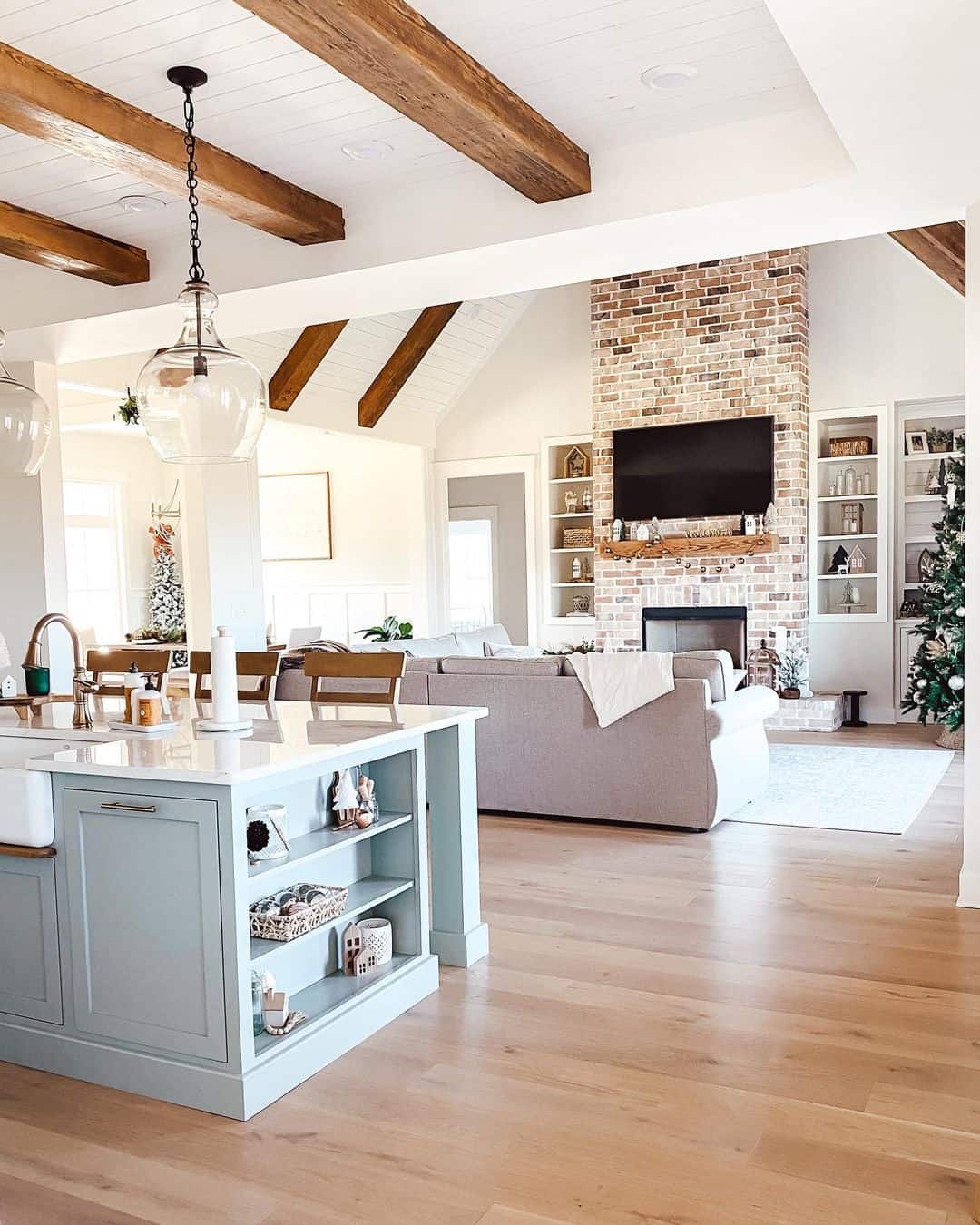
- Declutter: Keep countertops and surfaces clean and clutter-free.
- Hidden Storage: Invest in storage solutions that hide away clutter, such as built-in cabinets, drawers, or shelves.
- Multifunctional Furniture: Opt for furniture pieces with multiple uses, such as a sofa bed or a coffee table with hidden storage.
4. Lighting is Key:
- Layered Lighting: Combine overhead lighting with task lighting in the kitchen and accent lighting in the living area to create a balanced and functional space.
- Natural Light: Maximize natural light with large windows and skylights.
- Warm White Bulbs: Use warm white bulbs for a cozy and inviting atmosphere.

Furniture Selection: Choosing Pieces that Work
1. The Kitchen:
- Cabinets: Choose cabinets that are both functional and stylish. Consider incorporating open shelving for display.
- Countertops: Select durable countertops that can withstand daily wear and tear, such as granite, quartz, or laminate.
- Appliances: Choose appliances that are energy-efficient and have a sleek design.
- Dining Table & Chairs: Choose a dining table that fits comfortably in the designated zone. Opt for chairs that are both stylish and comfortable.
2. The Living Area:
- Sofa & Armchairs: Choose comfortable and stylish seating options that complement the overall aesthetic.
- Coffee Table: A coffee table serves as a focal point in the living area. Choose a table that provides ample surface space for drinks and snacks.
- Entertainment Center: If you have a TV, consider a dedicated entertainment center to house it and other electronics.
- Rugs & Throw Pillows: Add warmth and personality with a stylish area rug and decorative throw pillows.
3. Furniture Placement:
- Balance: Ensure that the furniture is balanced throughout the space.
- Visual Appeal: Create a visually appealing arrangement by grouping furniture and accessories.
- Functionality: Ensure that the furniture placement allows for easy movement and functionality.
Storage Solutions: Maximizing Space
1. Utilize Every Inch:
- Vertical Storage: Utilize wall space for open shelving, cabinets, or display units.
- Under-Cabinet Storage: Install drawers or shelves under cabinets to maximize storage space.
- Hidden Storage: Incorporate hidden storage solutions, such as a coffee table with drawers or a sofa with built-in compartments.
2. Multifunctional Furniture:
- Coffee Table with Storage: Choose a coffee table with drawers, shelves, or a hidden compartment for storing remote controls, magazines, or other items.
- Ottomans with Storage: Ottomans can double as extra seating and storage for blankets, toys, or other items.
- Sofa Beds: Opt for a sofa bed that can be converted into an extra bed for guests.
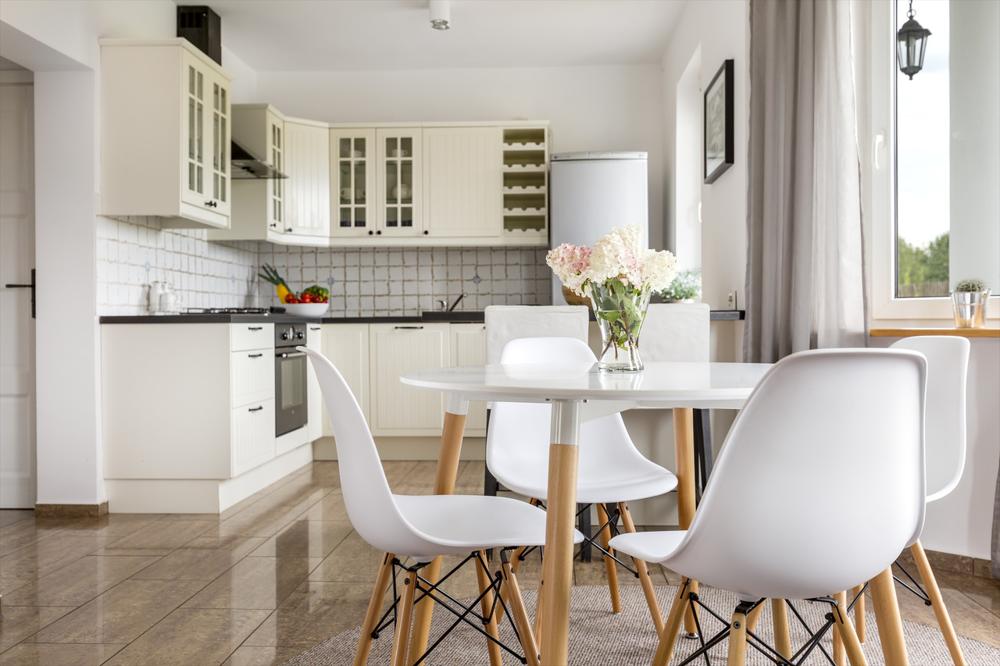
3. Declutter Regularly:
- Keep it Minimal: Only keep items that you use and love.
- Donate or Sell: Donate or sell items that you no longer need or use.
- Regularly Purge: Make decluttering a regular habit to ensure that your space remains organized and free from clutter.
Decor Tips: Adding Personality & Style
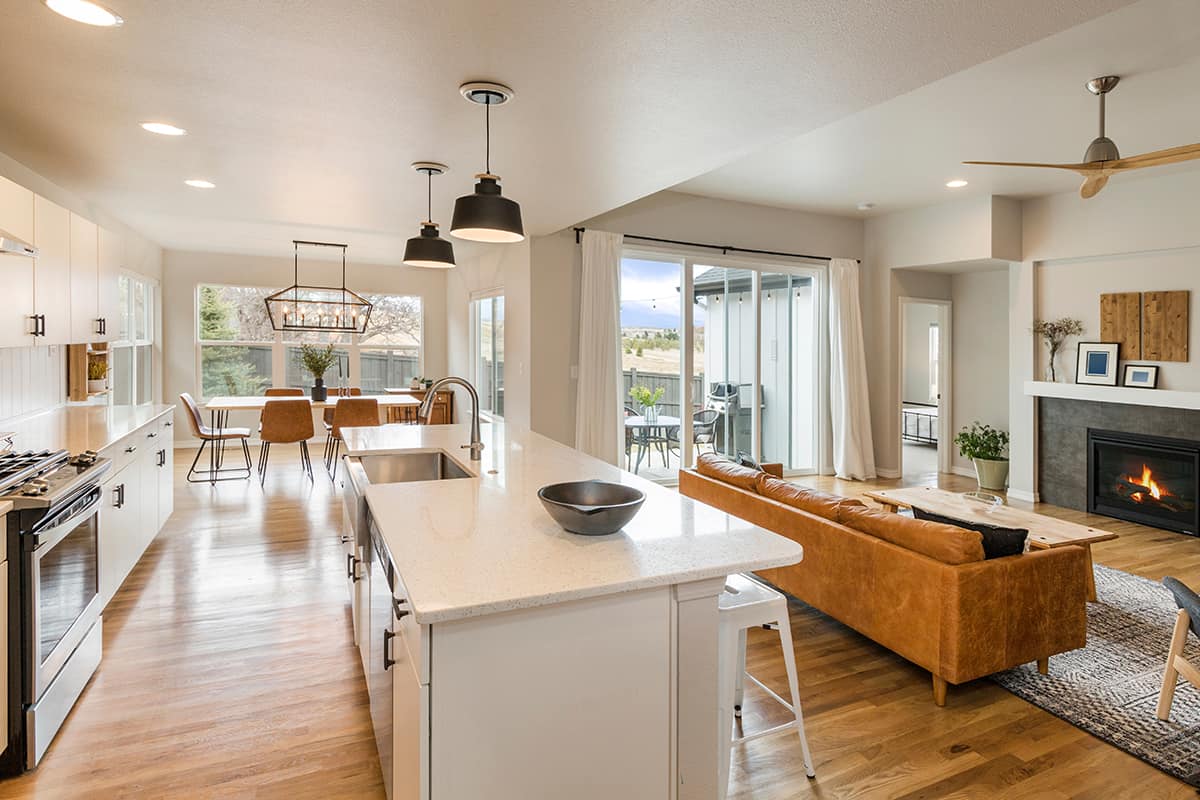
1. Art & Accents:
- Wall Art: Use artwork to create visual interest and add personality to the space.
- Mirrors: Mirrors can reflect light and make the space feel larger.
- Plants: Add greenery with plants to create a sense of freshness and life.
- Throws & Pillows: Add texture and color with throws and pillows.
2. Lighting:
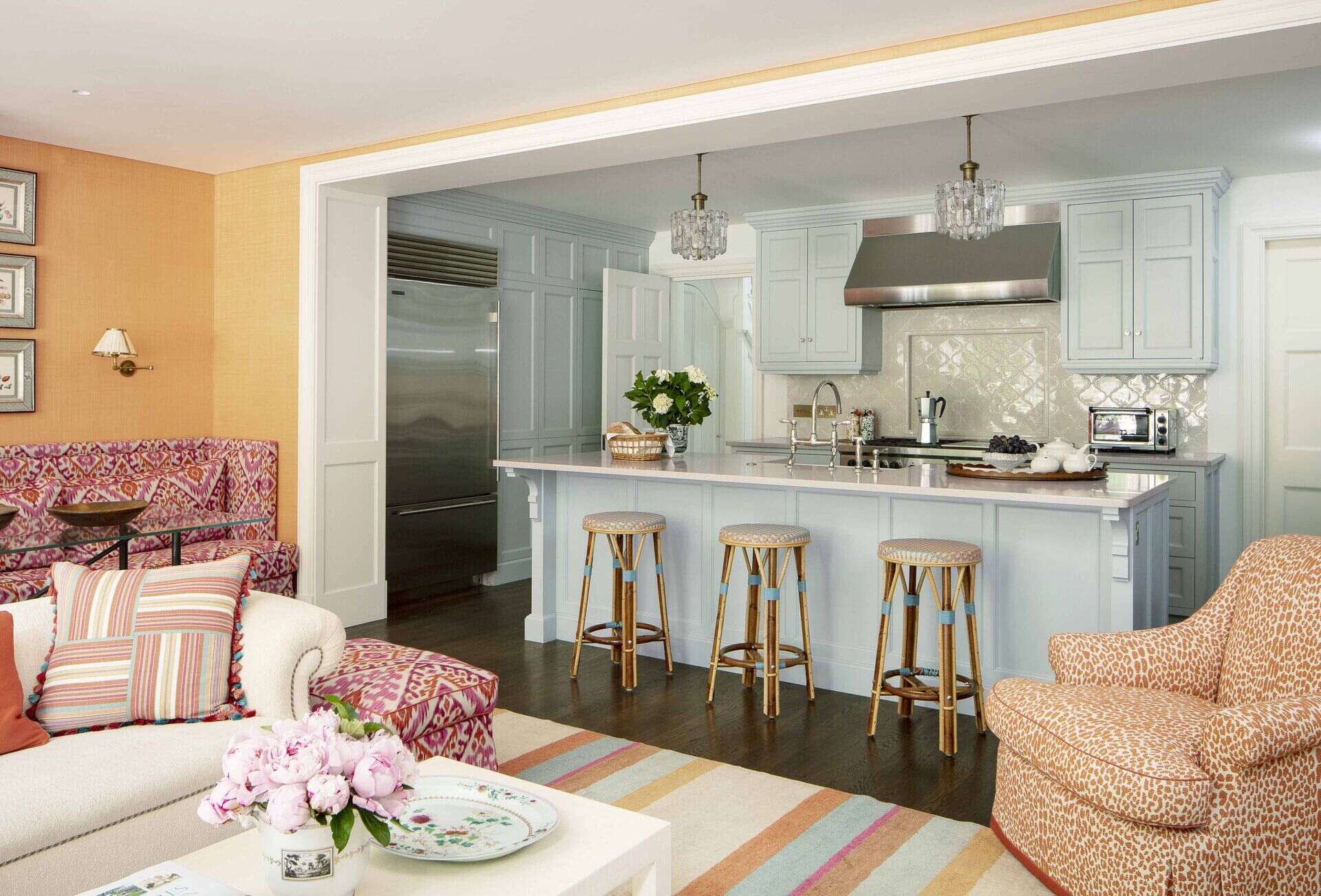
- Layered Lighting: Use a combination of overhead, task, and accent lighting to create a well-lit space.
- Natural Light: Maximize natural light with large windows and skylights.
- Dimmable Lighting: Use dimmable lights to create different moods and atmospheres.
3. Colour Palette:
- Neutral Base: Use neutral colours for the walls and larger furniture pieces.
- Accent Colors: Introduce pops of colour with throw pillows, artwork, or plants.
- Cohesive Theme: Choose a cohesive colour scheme that complements the overall style of the space.
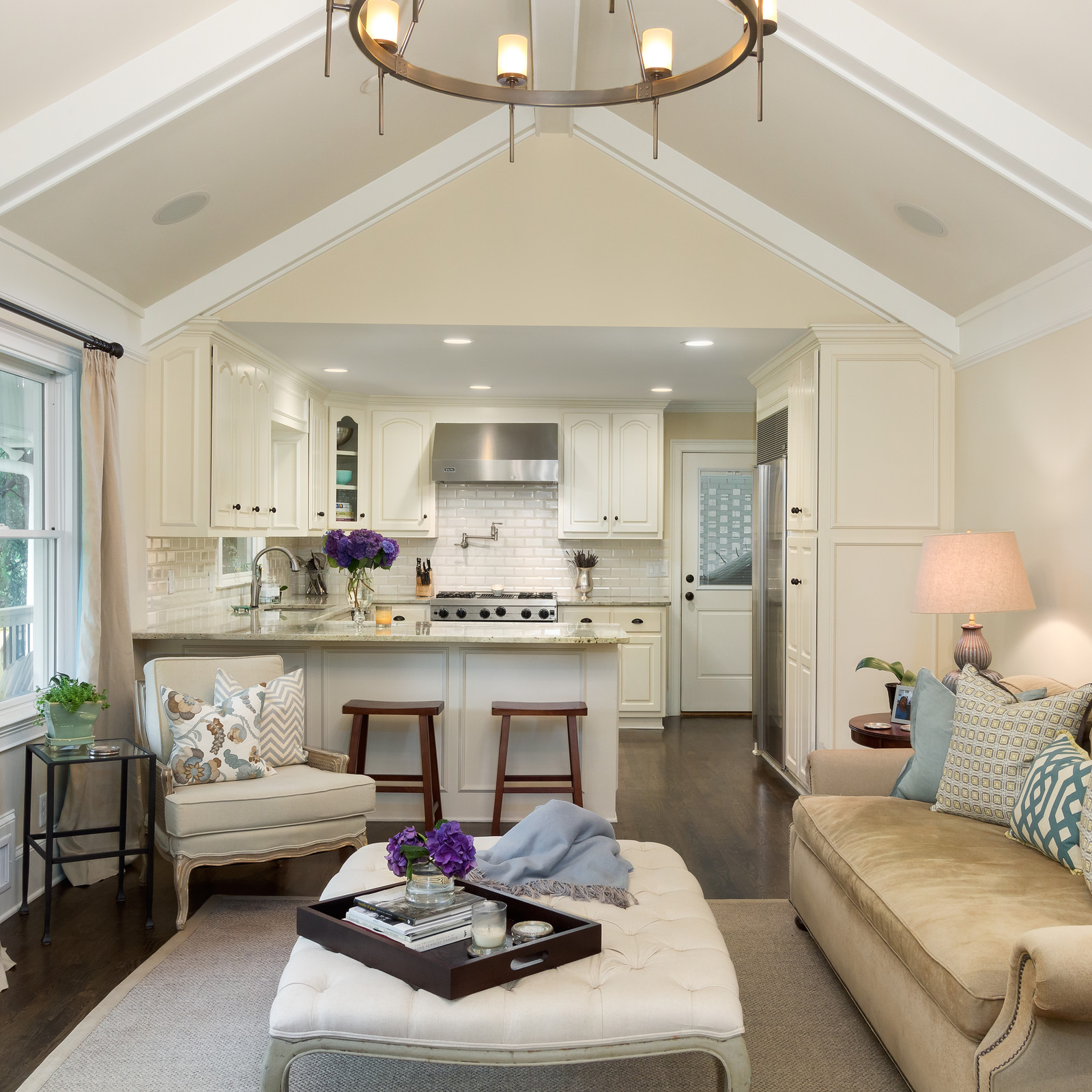
4. Embrace Your Style:
- Modern: Opt for clean lines, minimalist furniture, and metallic accents.
- Bohemian: Incorporate vibrant colours, textures, and patterns.
- Rustic: Use natural materials like wood, stone, and leather.
- Scandinavian: Embrace simplicity, functionality, and natural light.
Final Thoughts:
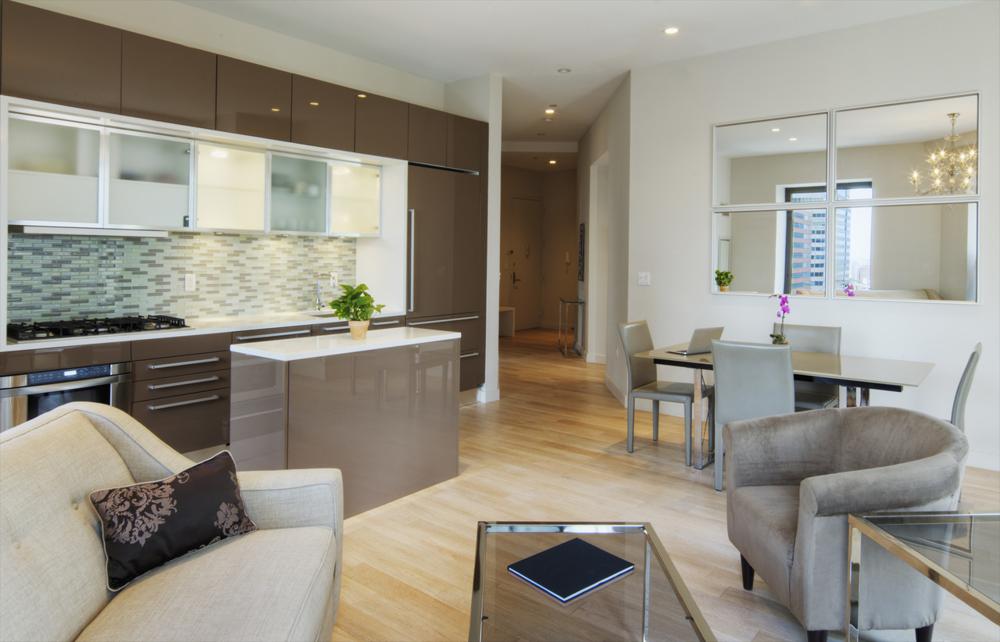
Creating a living room kitchen combo requires careful planning and attention to detail. By following these design guidelines, you can create a stylish and functional space that meets your unique needs and preferences. Remember, the key is to balance functionality with aesthetics, creating a space that is both welcoming and inspiring. Embrace your creativity, experiment with different design elements, and most importantly, personalize the space to reflect your individual style.
Tiny Home, Big Style: Living Room & Kitchen Combo Ideas
The allure of tiny homes is undeniable. They offer a simplified lifestyle, environmental consciousness, and often, a more affordable housing option. However, maximizing space within a limited footprint requires clever design choices. One common challenge in tiny homes is creating a functional and stylish living room and kitchen combo. This article will explore practical and aesthetically pleasing solutions for merging these two essential areas, demonstrating that even in a small space, you can achieve both functionality and beauty.
The Challenge of Combining Living Room and Kitchen
The primary challenge of merging living and kitchen spaces in a tiny home lies in achieving a balance between functionality and aesthetics. The kitchen needs to be practical for cooking and meal preparation, while the living room should provide a comfortable and inviting space for relaxation and socializing. Here are some key considerations:
- Defining Space: Without clear boundaries, the combined area can feel chaotic and cramped. Creating distinct zones visually and functionally is crucial.
- Traffic Flow: Efficiently navigating the space is vital, especially when preparing meals or moving between seating areas.
- Storage: Limited space necessitates intelligent storage solutions to prevent clutter and maintain a sense of order.
- Visual Appeal: While functionality is essential, the combined area should be visually appealing and inviting, creating a sense of spaciousness and style.
Design Strategies for a Seamless Combination
1. Open Floor Plan: This classic approach maximizes visual space by eliminating walls and creating an open, flowing layout. This strategy can be particularly effective in small spaces, creating a sense of expansiveness.
2. Multifunctional Furniture: This approach utilizes furniture that serves multiple purposes, maximizing functionality and minimizing clutter. Consider pieces like:
- Sofa Beds: These provide comfortable seating during the day and convert into a sleeping area for guests or occasional use.
- Storage Ottomans: These offer a convenient place to rest your feet while also providing concealed storage for blankets, games, or other items.
- Kitchen Islands: These can double as a dining table, breakfast bar, or additional workspace.
3. Color Palette: Employing a cohesive color palette can unify the space and create a sense of flow.
- Light and Airy: Neutral colors like white, beige, and gray reflect light, making the space feel larger.
- Pops of Color: Introducing accent colors through pillows, throws, or artwork adds visual interest and personality.
- Wood Accents: Warm wood tones can create a cozy atmosphere and complement both the living room and kitchen.
4. Lighting: Proper lighting is essential to create a functional and inviting environment.
- Ambient Lighting: Overhead fixtures provide general illumination.
- Task Lighting: Under-cabinet lights or pendant lights over the kitchen island enhance visibility for cooking and food preparation.
- Accent Lighting: Table lamps or sconces add warmth and ambiance to the living area.

5. Storage Solutions: Efficient storage is crucial in a tiny home.
- Wall-Mounted Shelves: This minimizes floor space and provides easy access to frequently used items.
- Drawer Systems: Utilize cabinets and drawers to keep items organized and out of sight.
- Vertical Storage: Consider a vertical pantry, a narrow cabinet with adjustable shelves, or even a tiered spice rack to maximize vertical space.
6. Zoning: Creating distinct zones within the combined space helps to define areas and enhance functionality.

- Visual Separation: Use rugs, curtains, or different flooring materials to delineate the living and kitchen areas.
- Furniture Placement: Position furniture to create distinct zones. A sofa and coffee table can mark the living room area, while a dining table or island can define the kitchen space.
Inspiring Tiny Home Living Room & Kitchen Combo Ideas
1. Rustic Charm: This design aesthetic embraces natural elements, creating a warm and inviting atmosphere.
- Materials: Use reclaimed wood for flooring, countertops, and furniture.
- Colors: Employ earthy tones like browns, greens, and cream.
- Lighting: Utilize pendant lights with exposed bulbs or rustic chandeliers.
- Decor: Incorporate elements like exposed brick, woven baskets, and vintage metal signs.
2. Minimalist Chic: This approach prioritizes functionality and simplicity, creating a clean and uncluttered space.
- Materials: Opt for sleek, modern materials like stainless steel, concrete, and glass.
- Colors: Stick to a limited color palette, with white, gray, and black as dominant hues.
- Furniture: Choose minimalist pieces with clean lines and a focus on practicality.
- Decor: Minimize decorative elements, focusing on functional items like storage baskets and sleek planters.
3. Bohemian Rhapsody: This design style embraces eclecticism and artistic expression, creating a vibrant and personalized space.
- Materials: Use a mix of textures and patterns, including woven fabrics, ethnic textiles, and vintage furniture.
- Colors: Experiment with bold, vibrant colors and patterns.
- Lighting: Utilize statement lighting fixtures with unique shapes and designs.
- Decor: Incorporate a mix of eclectic elements, including artwork, plants, and souvenirs from travels.
4. Industrial Style: This design aesthetic draws inspiration from factories and warehouses, creating a raw and edgy space.
- Materials: Use exposed brick, metal piping, and reclaimed wood.
- Colors: Employ a neutral palette with accents of black, gray, and rust.
- Furniture: Choose industrial-inspired pieces with metal frames and distressed finishes.
- Decor: Incorporate elements like vintage lighting fixtures, metal storage containers, and exposed brick walls.
5. Modern Farmhouse: This design style blends modern and farmhouse elements, creating a cozy and stylish space.
- Materials: Use natural materials like wood, stone, and linen.
- Colors: Opt for neutral colors with touches of warm tones like beige, cream, and olive green.
- Furniture: Choose farmhouse-inspired pieces with distressed finishes and natural wood accents.
- Decor: Incorporate elements like farmhouse signs, vintage metal containers, and fresh flowers.

Tips for Making the Most of Your Space
1. Utilize Vertical Space: Optimize vertical space for storage. Wall shelves, cabinets, and hanging baskets can keep items organized and off the floor.
2. Create a Focal Point: Draw the eye to a particular area with a captivating element, such as a unique artwork, a bold-colored rug, or a statement light fixture. This helps create a sense of depth and visual interest.

3. Embrace Multifunctional Furniture: Look for furniture pieces that serve multiple purposes. Foldable tables, storage ottomans, and convertible sofa beds are excellent space-saving solutions.
4. Prioritize Comfort: Ensure the living area is comfortable and inviting. Choose a comfortable sofa or armchair, and consider adding plush throws and pillows for an extra layer of comfort.
5. Keep It Clean and Organized: Maintain a sense of order and spaciousness by keeping surfaces clear and clutter to a minimum. This will help create a sense of calm and relaxation.

6. Add Plants: Plants add life and vibrancy to any space. Consider using a variety of plants in different sizes and shapes to create a visually appealing and refreshing atmosphere.
7. Use Mirrors Strategically: Mirrors can create the illusion of more space by reflecting light and expanding the visual field. Place a mirror opposite a window to maximize natural light or in a corner to reflect more of the space.
8. Don't Overcrowd: Resist the urge to fill every available inch with furniture and decor. Allow for breathing room and create a sense of openness.

9. Embrace the Tiny Home Lifestyle: Embrace the minimalist lifestyle that comes with living in a tiny home. Choose items that are both functional and aesthetically pleasing, and learn to live with less.
10. Get Creative: Tiny homes provide an opportunity to experiment and create unique and personalized living spaces. Don't be afraid to think outside the box and come up with innovative solutions for merging your living room and kitchen.
Conclusion:

Combining a living room and kitchen in a tiny home can be a design challenge, but it is also an opportunity to create a beautiful, functional, and inviting space. By implementing the strategies and ideas outlined in this article, you can transform your small home into a stylish and comfortable haven. Remember, the key to success lies in prioritizing functionality, creating a sense of flow, and embracing the unique charm of tiny home living. .

